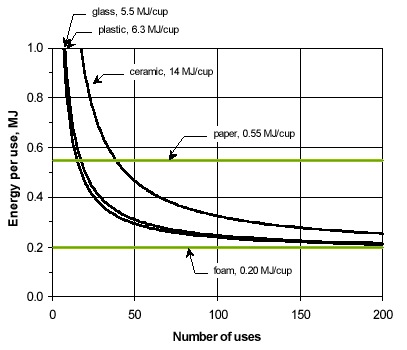You gotta love anything disposable, and now the research to back up what I always knew – anything that avoids doing the dishes has to be a good idea
Here’s a life-cycle energy analysis on reusable vs. disposable cups -another data set to look at would be from washing a cup in the sink (I have a dishwasher and never wash cups in it) but that said, a lot of people use a dishwasher for everything. There are other factors like soap production, transportation costs, etc too, but then it would be really confusing.It’s interesting to note that a ceramic cup takes 1,000 uses to break even with foam cups. so, about 3 years if you use a cup every day – that’s not so bad — perhaps someone could make a line of coffee cups that say "use me for 3 years to recoup the energy costs" it would make the cup more important and more heirloom-like. People would try and save the cup for as many years as possible to be efficient. Maybe bight green cups with the date of creation on the bottom.
Someone tell treehugger.
This classic life-cycle energy analysis was performed by University of Victoria professor of chemistry Martin B. Hocking. Hocking compared three types of reusable drinking cups (ceramic, glass and reusable plastic) to two types of disposable cups (paper and polystyrene foam).
The energy of manufacture of reusable cups is vastly larger than the energy of manufacture of disposable cups (Table 1). In order for a reusable cup to be an improvement over a disposable one on an energy basis, you have to use it multiple times, in order to "cash in" on the energy investment you made in the cup. If a cup lasts only ten uses, then each use gets "charged’ for one-tenth of the manufacturing energy. If it lasts for a hundred uses, then each use gets charged for only one-hundredth of the manufacturing energy.
But in order to reuse a cup, it has to be washed. The efficiency of the dishwasher, and the efficiency of the energy system that powers it, determine how much energy is required for each wash.
Institute for Lifecycle Environmental Assessment, thanks Saul Link.
From MAKE Magazine
